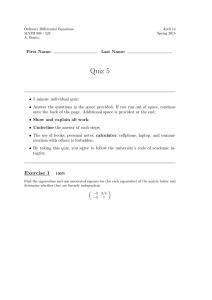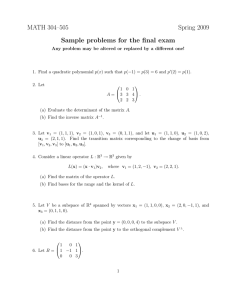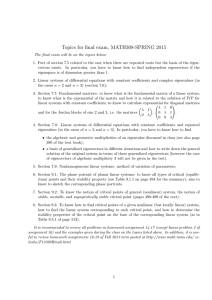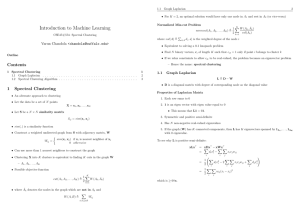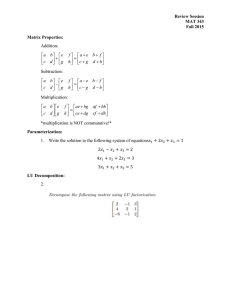Spectral Clustering Royi Itzhak
advertisement
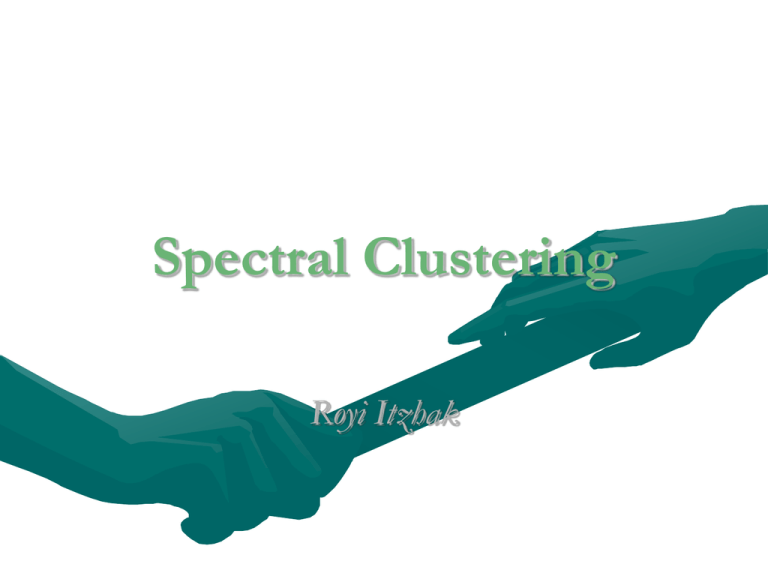
Spectral Clustering
Royi Itzhak
Spectral Clustering
• Algorithms that cluster points using
eigenvectors of matrices derived from the data
• Obtain data representation in the lowdimensional space that can be easily clustered
• Variety of methods that use the eigenvectors
differently
• Difficult to understand….
Elements of Graph Theory
• A graph G = (V,E) consists of a vertex set V and an edge
set E.
• If G is a directed graph, each edge is an ordered pair of
vertices
• A bipartite graph is one in which the vertices can be
divided into two groups, so that all edges join vertices
in different groups.
Similarity Graph
• Distance decrease similarty increase
• Represent dataset as a weighted graph G(V,E)
V={xi}
E={Wij}
{v1 , v2 ,..., v6 }
Set of n vertices representing data points
Set of weighted edges indicating pair-wise
similarity between points
0.1
0.8
5
1
0.8
0.8
0.6
2
6
4
0.8
3
0.2
0.7
Similarity Graph
• Wij represent similarity between vertex
• If Wij=0 where isn’t similarity
• Wii=0
Graph Partitioning
• Clustering can be viewed as
partitioning a similarity graph
• Bi-partitioning task:
– Divide vertices into two disjoint
groups (A,B) A
2
4
3
V=A U B
Graph partition is NP hard
B
5
1
6
Clustering Objectives
•
Traditional definition of a “good” clustering:
1.
2.
•
Points assigned to same cluster should be highly similar.
Points assigned to different clusters should be highly dissimilar.
Apply these objectives to our graph representation
0.8
0.1
1
5
0.8
0.6
2
0.8
0.8
3
6
4
0.7
0.2
Minimize weight of between-group connections
Graph Cuts
• Express partitioning objectives as a function of the
“edge cut” of the partition.
• Cut: Set of edges with only one vertex in a group.we
wants to find the minimal cut beetween groups. The
groups that has the minimal cut would be the partition
A
cut ( A, B)
B
iA, jB
0.1
0.8
1
0.8
3
5
0.8
0.6
2
0.7
ij
0.8
6
4
0.2
w
cut(A,B) = 0.3
Graph Cut Criteria
• Criterion: Minimum-cut
– Minimise weight of connections between groups
min cut(A,B)
• Degenerate case:
Optimal cut
Minimum cut
• Problem:
– Only considers external cluster connections
– Does not consider internal cluster density
Graph Cut Criteria (continued)
• Criterion: Normalised-cut (Shi & Malik,’97)
– Consider the connectivity between groups
relative to the density of each group.
min Ncut ( A, B)
cut ( A, B) cut ( A, B)
vol( A)
vol( B)
– Normalise the association between groups by volume.
• Vol(A): The total weight of the edges originating from
group A.
• Why use this criterion?
– Minimising the normalised cut is equivalent to
maximising normalised association.
– Produces more balanced partitions.
Second option
The previous criteria was on he weight
This following criteria is on the size of the group
A B N
A number _ of _ vertexes _ on _ A
B number _ of _ vertexes _ on _ B
A B N
0
A B
1
A or B N
thats
0 1
Example – 2 Spirals
2
Dataset exhibits complex
cluster shapes
1.5
1
0.5
0
-2
-1.5
-1
-0.5
0
0.5
1
1.5
2
-0.5
-1
K-means performs very
poorly in this space due bias
toward dense spherical
clusters.
-1.5
-2
0.8
0.6
0.4
0.2
In the embedded space
given by two leading
eigenvectors, clusters are
trivial to separate.
-0.709
-0.7085
-0.708
-0.7075
-0.707
-0.7065
0
-0.706
-0.2
-0.4
-0.6
-0.8
Spectral Graph Theory
• Possible approach
– Represent a similarity graph as a matrix
– Apply knowledge from Linear Algebra…
• The eigenvalues and eigenvectors
of a matrix provide global
information about its
structure.
w11
wn1
w1n
wnn
x1
λ
xn
x1
xn
• Spectral Graph Theory
– Analyse the “spectrum” of matrix representing a graph.
– Spectrum : The eigenvectors of a graph, ordered by the
magnitude(strength) of their corresponding eigenvalues.
{1 , 2 ,..., n }
Matrix Representations
• Adjacency matrix (A)
– n x n matrix
– A [ wij ] : edge weight between vertex xi and xj
0.1
0.8
5
1
0.8
0.6
2
0.8
0.8
6
4
0.7
3
0.2
x1
x2
x3
x4
x5
x6
x1
0
0.8
0.6
0
0.1
0
x2
0.8
0
0.8
0
0
0
x3
0.6
0.8
0
0.2
0
0
x4
0
0
0.2
0
0.8
0.7
x5
0.1
0
0
0.8
0
0.8
x6
0
0
0
0.7
0.8
0
• Important properties:
– Symmetric matrix
Eigenvalues are real
Eigenvector could span orthogonal base
Matrix Representations (continued)
• Degree matrix (D)
– n x n diagonal matrix
– D(i, i) wij: total weight of edges incident to vertex xi
j
0.1
0.8
5
1
0.8
0.6
2
0.8
3
0.8
6
4
0.2
0.7
• Important application:
– Normalise adjacency matrix
x1
x2
x3
x4
x5
x6
x1
1.5
0
0
0
0
0
x2
0
1.6
0
0
0
0
x3
0
0
1.6
0
0
0
x4
0
0
0
1.7
0
0
x5
0
0
0
0
1.7
0
x6
0
0
0
0
0
1.5
Matrix Representations (continued)
• Laplacian matrix (L)
– n x n symmetric matrix
0.1
0.8
5
1
0.8
0.6
2
0.8
0.8
6
4
0.7
3
0.2
L=D-A
x1
x2
x3
x4
x5
x6
x1
1.5
-0.8
-0.6
0
-0.1
0
x2
-0.8
1.6
-0.8
0
0
0
x3
-0.6
-0.8
1.6
-0.2
0
0
x4
0
0
-0.2
1.7
-0.8
-0.7
x5
-0.1
0
0
-0.8
1.7
-0.8
x6
0
0
0
-0.7
-0.8
1.5
• Important properties:
– Eigenvalues are non-negative real numbers
– Eigenvectors are real and orthogonal
– Eigenvalues and eigenvectors provide an insight into the
connectivity of the graph…
Another option – normalized laplasian
• Laplacian matrix (L)
– n x n symmetric matrix
0.1
0.8
5
1
0.8
0.6
2
0.8
0.8
6
4
0.7
3
0.2
• Important properties:
D0.5 ( D A) D0.5
1.00
-0.52
-0.39
0.00
-0.06
0.00
-0.52
1.00
-0.50
0.00
0.00
0.00
-0.39
-0.50
1.00
0.00
0.00
0.00
0.00
-0.12
1.00
0.47-
0.44-
-0.06
0.00
0.00
-0.47
1.00
0.50-
0.00
0.00
0.00
0.44-
0.50-
1.00
– Eigenvectors are real and normalize
– Each Aij (which i,j is not equal) = Aij
Dii
-0.12
Find An Optimal Min-Cut (Hall’70,
Fiedler’73)
• Express a bi-partition (A,B) as a vector
1 if xi A
T
p
Lp
pi
1 if xi B
• The laplacian is semi positive
• The Rayleigh
shows:
W Theorem
•
– The minimum
value for f(p) is given by
e
Laplacian
matrix
f ( p) wij( pi pj )2
i, jV
the 2nd smallest
eigenvalue of the Laplacian L.
c
a solution for p is given by the corresponding
– The optimal
n λ , referred as the Fiedler Vector.
eigenvector
2
m
i
Proof
•
Based on
•
Consistency of Spectral Clustering
By Ulrike von Luxburg1, Mikhail Belkin2, Olivier Bousquet
Max Planck Institute for Biological Cybernetics
Pages 2-6
Proof
Some definitions:
deg(i ) wij
vol ( s) deg(i), vol ( s) cut
is
bw ( g ) min cut ( s)
sv , vol ( s ) vol ( s )
Define f as follows
1,[i ] S
f si N
1,[i ] S
Only the vertex that have edge between them T
f s Lf s wij ( f s f s )2 4vol ( s)
from different set would be meaningful
For each edge the sum is on the diagonal
f sT Df s wij vol (v)
i
j
f sT D1 deg[i] deg[i] vol ( s) vol ( s)
[ i ]s
[ i ]s
Hence it would be equal to zero only than vol(s)=vol(s’) now it could
definite b ( g ) as b ( g ) min f t Lf
w
w
f {1, 1}, fD1 0
Continue …
From simple algebra..
vol (v)
f t Lf
bw ( g )
min t
4
f Df
f {1, 1}, fD1 0
The relaxation method is for each
n
vector on
Lf
Eigen value worth
Df
f t Lf
bw ( g ) min t
f Df
f
n
, fD1 0
Because the min of eigenvalue is 0 it doesn’t give us any
information ,and that’s why its bw(g)=2nd eigenvalue
Spectral Clustering Algorithms
•
Three basic stages:
1. Pre-processing
•
Construct a matrix representation of the dataset.
2. Decomposition
•
•
Compute eigenvalues and eigenvectors of the matrix.
Map each point to a lower-dimensional representation
based on one or more eigenvectors.
3. Grouping
•
Assign points to two or more clusters, based on the new
representation.
Spectral Bi-partitioning Algorithm
x1
1.
Pre-processing
–
2.
Build Laplacian
matrix L of the
graph
Decomposition
–
–
Find eigenvalues X
and eigenvectors Λ
of the matrix L
Map vertices to
corresponding
components of λ2
Λ=
x2
x3
x4
x5
x6
x1
1.5
-0.8 -0.6
0
-0.1
0
x2
-0.8
1.6
-0.8
0
0
0
x3
-0.6 -0.8
1.6
-0.2
0
0
x4
0
0
-0.2
1.7
-0.8 -0.7
x5
-0.1
0
0
-0.8
1.7
-0.8
x6
0
0
0
-0.7 -0.8
1.5
0.0
0.4
0.2
0.1
0.4
-0.2
-0.9
0.4
0.4
0.2
0.1
-0.
0.4
0.3
0.4
0.2
-0.2
0.0
-0.2
0.6
0.4
-0.4
0.9
0.2
-0.4
-0.6
2.5
0.4
-0.7
-0.4
-0.8
-0.6
-0.2
3.0
0.4
-0.7
-0.2
0.5
0.8
0.9
2.2
2.3
x1
0.2
x2
0.2
x3
0.2
x4
-0.4
x5
-0.7
x6
-0.7
X=
Spectral Bi-partitioning Algorithm
The matrix which represents the eigenvector of the laplacian the
eigenvector matched to the corresponded eigenvalues with increasing order
0.41
-0.41
0.65-
0.31-
0.38-
0.11
0.41
-0.44
0.01
0.30
0.71
0.22
0.41
-0.37
0.64
0.04
0.39-
0.37-
0.41
0.37
0.34
0.45-
0.00
0.61
0.41
0.41
0.17-
0.30-
0.35
0.65-
0.41
0.45
0.18-
0.72
0.29-
0.09
6
5
4
3
2
1
Spectral Bi-partitioning (continued)
•
Grouping
–
–
•
Sort components of reduced 1-dimensional vector.
Identify clusters by splitting the sorted vector in two.
How to choose a splitting point?
–
Naïve approaches:
•
–
Split at 0, mean or median value
More expensive approaches
•
Attempt to minimise normalised cut criterion in 1-dimension
x1
x2
x3
x4
x5
x6
0.2
Split at 0
0.2
Cluster A: Positive points
Cluster B: Negative points
0.2
-0.4
-0.7
-0.7
x1
x2
x3
0.2
0.2
0.2
x4
x5
x6
-0.4
-0.7
-0.7
A
B
3-Clusters
Lets assume the next data points
• If we use the 2nd eigen
vector
• If we use the 3rd eigen
vector
K-Way Spectral Clustering
• How do we partition a graph into k clusters?
•
Two basic approaches:
1. Recursive bi-partitioning (Hagen et al.,’91)
• Recursively apply bi-partitioning algorithm in a
hierarchical divisive manner.
• Disadvantages: Inefficient, unstable O(n3 )
2. Cluster multiple eigenvectors (Shi & Malik,’00)
• Build a reduced space from multiple eigenvectors.
• Commonly used in recent papers
• A preferable approach…but its like to do PCA and then
k-means
Recursive bi-partitioning (Hagen et al.,’91)
• Partition using only one eigenvector at a time
• Use procedure recursively
• Example: Image Segmentation
– Uses 2nd (smallest) eigenvector to define optimal cut
– Recursively generates two clusters with each cut
Why use Multiple Eigenvectors?
1. Approximates the optimal cut (Shi & Malik,’00)
– Can be used to approximate the optimal k-way normalised cut.
2. Emphasises cohesive clusters (Brand & Huang,’02)
– Increases the unevenness in the distribution of the data.
Associations between similar points are amplified, associations
between dissimilar points are attenuated.
The data begins to “approximate a clustering”.
3. Well-separated space
– Transforms data to a new “embedded space”, consisting of k
orthogonal basis vectors.
• NB: Multiple eigenvectors prevent instability due to
information loss.
K-Eigenvector Clustering
•
K-eigenvector Algorithm (Ng et al.,’01)
1. Pre-processing
– Construct the scaled adjacency matrix
A' D1/ 2 AD1/ 2
2. Decomposition
• Find the eigenvalues and eigenvectors of A'.
• Build embedded space from the eigenvectors
corresponding to the k largest eigenvalues.
3. Grouping
• Apply k-means to reduced n x k space to produce k
clusters.
Aside: How to select k?
Eigengap: the difference between two consecutive eigenvalues. •
Most stable clustering is generally given by the value k that maximises •
the expression
k k k 1
Largest eigenvalues
of Cisi/Medline data
50
λ1
45
40
Choose k=2
Eigenvalue
max k 2 1
35
30
25
λ2
20
15
10
5
0
1
2
3
4
5
6
7
8
9
10 11 12 13 14 15 16 17 18 19 20
K
Conclusion
• Clustering as a graph partitioning problem
– Quality of a partition can be determined using graph
cut criteria.
– Identifying an optimal partition is NP-hard.
• Spectral clustering techniques
– Efficient approach to calculate near-optimal
bi-partitions and k-way partitions.
– Based on well-known cut criteria and strong
theoretical background.
Selecting relevant genes with
spectral approach
Genomics
Goal: recognizing the relevant
genes that separate between
cells with different biological
characteristics (normal vs. tumor,
different subclasses of tumor cells)
• Classification of Tissue Samples (type of
Cancer, Normal vs. Tumor)
• Find Novel Subclasses (unsupervised)
• Find Genes responsible for classification
(new insights for drug design).
tissue samples
Gene expressions
The microarray technology provides
many measurements of gene
expressions for different sample
tissues.
Few samples (~50) and large dimension (~10,000)
Problem Definition
lets the microarray data matrix define by M
M [M1 ,..., M q ] Rnq
M1
Mi
Mq
The gene expression levels form the rows of M
m ,..., m
T
i1
T
is
Normalized gene vector
mi
2
1
....
m1T
m2T
which are most “relevant” with respect to an
inference (learning) task.
mnT
tissue vector
Feature Subset Relevance - Key Idea
Mi Rn
ˆ Rl l n
M
i
M1
ˆ
M
1
ˆ
M
i
Mi
ˆ
M
q
Rl
Mq
m1T
m2T
mnT
Working Assumption: the relevant subset of rows induce columns that are coherently clustered.
• How to measure cluster coherency? We wish to avoid explicitly clustering
for each subset of rows. We wish a measure which is amenable to
continuous functional analysis.
ˆ TM
ˆ
key idea: use spectral information from the affinity matrix M
ˆ
M
q
ˆ
M
i
ˆ
M
1
ˆ
M
ˆ TM
ˆ ?
• How to represent M
s i1 ,..., il
subset of features
n
Tˆ
ˆ
A M M i mi mTi
i1
is
1
0 otherwise
i
Correlation matrix between I’th and j’th
Column (symmetric-positive)
Definition of Relevancy
The Standard Spectrum
General Idea:
Select a subset of rows from the sample matrix M such that the resulting
affinity matrix will have high values associated with the first k eigenvalues.
s i1 ,..., il
subset of features
A i 1 i mi miT
n
is
1
i
0 otherwise
rel ( xi1 ,..., xil ) trace(QT AT A Q ) k 2
j 1 j
Q
consists of the first k eigenvectors of
A
Optimization Problem
Let
A i 1 i mi miT
n
for some unknown real scalars
max traceQT AT A Q
Q ,1 ,..., n
subject to
QT Q I
n
2
i 1
i 1
1 ,..., n T
Motivation: from spectral clustering it is known
that the eigenvectors tend to be discontinuous
and that may lead to an effortless sparsity
property.
The Q Algorithm
max traceQT AT A Q
Q ,1 ,..., n
If
were known, then A
T 1
QT Q I
is known and Q is simply the first k eigenvectors of
If Q were known, then the problem becomes:
max T G
1 ,..., n
where
subject to
T 1
Gij (miT m j )miT QT Qm j
is the largest eigenvector of G
A
The Q Algorithm
Power-embedded
1. Let G
(r )
be defined
(r )
ij
G
(m m j )m Q
T
i
2.
Let (r ) be the largest eigenvector of
3.
Let
A( r ) i 1 i( r ) mi miT
4.
Let
Z ( r ) A( r )Q ( r 1)
5.
T
i
( r 1)T
Q ( r 1) m j
G (r )
n
QR
Z ( r )
Q(r ) R(r )
“QR” factorization step
6. Increment r
Note that r-is the index of iterations
orthogonal iteration
The algorithm need 3 conditions:
• the algorithm converges to a local maximum
• At the local maximum i 0
• The vector is sparse
The experiment
• Giving some data sets: blood cell
• Myeloid cell: HL-60 U937.
• T cell-Jurkat,
• Leukemia cell NB4
• The dimensionality of the expression data was 7229 genes
over 17 sampeles
• The goal is to find cluster of the expression level of the
gene without any restriction.
SOM
Principle of SOMs. Initial geometry of nodes in 3 × 2 rectangular grid is
indicated by solid lines connecting the nodes. Hypothetical trajectories of nodes
as they migrate to fit data during successive iterations of SOM algorithm are
shown. Data points are represented by black dots, six nodes of SOM by large
circles, and trajectories by arrows.
Copyright ©1999 by the National Academy of Sciences
S.O.M Results
• the time course data
with s.o.m and after
pre-processing of the
data
• The results was 24
cluster each cluster
consists 6-113 genes
Q-alpha
After applying to Q-alpha algorithmwas found that
The set of relevant genes was consists
from small number of relevant genes on
the you can see plot of the sorted –alpha
The profile of the values indicates
sparsity meaning that around 95% of the
values are of an order of magnitude
smaller than the remaining 5%.
continue
A plot of 6 of the top 40 genes that correspond to clusters 20, 1, 22/23, 4, 15, 21 In
each of the six panels time courses of all four cell lines are shown (left to
right) HL-60, U937, NB4, Jurkat.
Another example
• Another dataset :
1. DLCL, reffered to as ”lymphoma” 7, 129 genes over 56 samples
2. Childhood medulloblastomas referred to as ”brain”. The
dimensionality of this dataset was 7, 129 and there were 60 samples
3. Breast tumors reffered to as ”breast met”. The dimensionality
of this dataset was 24,624 and there were 44 samples where
4. The fourth breast tumors for which corresponding lymph nodes either
were cancerous or not, referred to as ”lymph status”. The
dimensionality of this dataset is 12, 600 with 90 samples
The results-using leave one out
algorithm
• Compare to unsupervised method like PCA,GS
and supervised methods like SNR,RMB,RFE
The slide you all waited for



